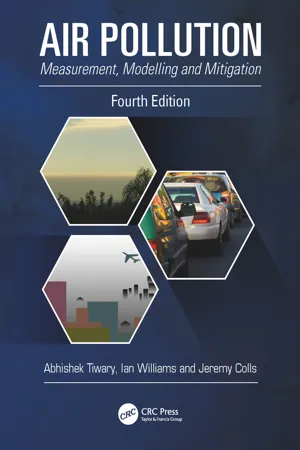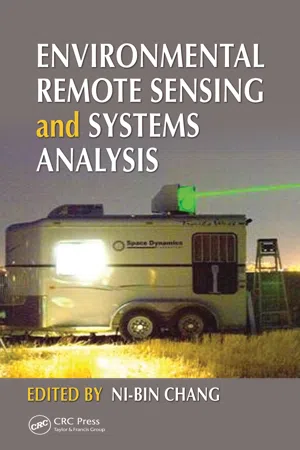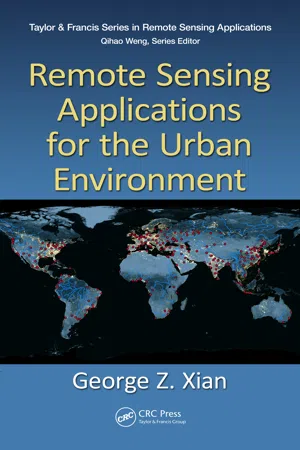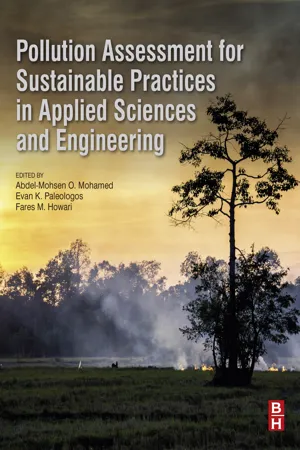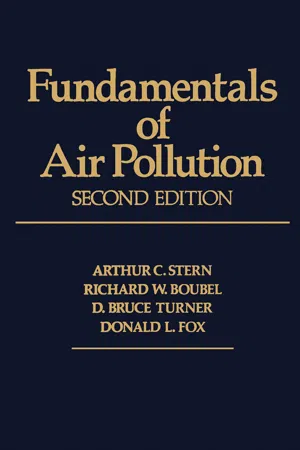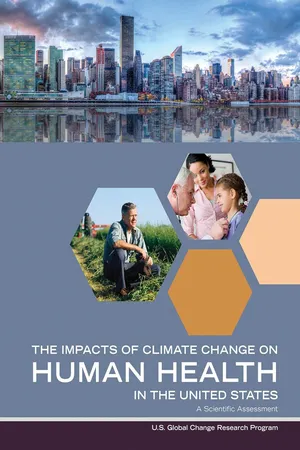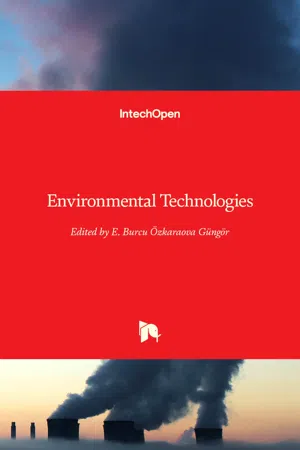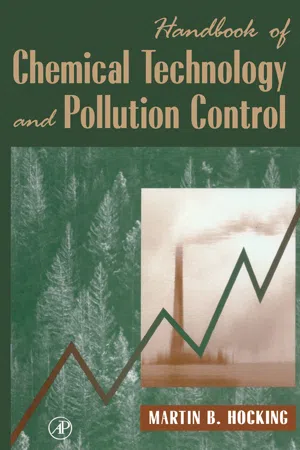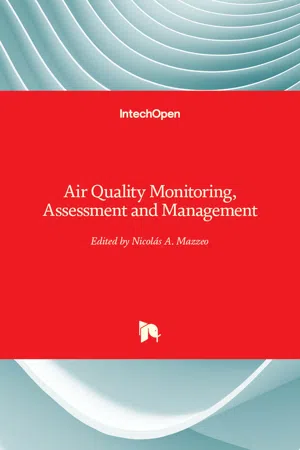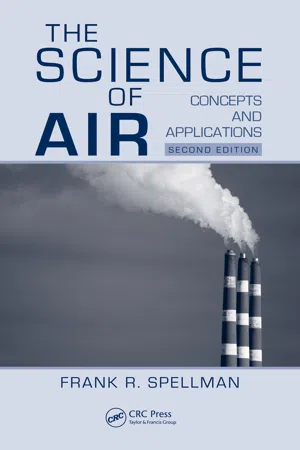Geography
Air Quality
Air quality refers to the condition of the air in terms of the presence of pollutants and other harmful substances. It is measured by factors such as the concentration of particulate matter, ozone, carbon monoxide, sulfur dioxide, and nitrogen dioxide. Poor air quality can have detrimental effects on human health, ecosystems, and the environment.
Written by Perlego with AI-assistance
Related key terms
1 of 5
10 Key excerpts on "Air Quality"
- eBook - ePub
Air Pollution
Measurement, Modelling and Mitigation, Fourth Edition
- Abhishek Tiwary, Ian Williams(Authors)
- 2018(Publication Date)
- CRC Press(Publisher)
Chapter 6 Ambient Air QualityAir Quality is an abstract term referring to the air pollution levels in the context of exposure to humans. However, a more generalised scope of Air Quality also includes the levels of air pollutant exposure to buildings, crops, vegetation, and so on. Ambient refers to a criterion (or standard) relating to the immediate outdoor (or indoor) surroundings. Ambient Air Quality varies greatly from place to place at any one time, and with the time of day and from year to year at any one place. This is the result of the rapid variations in the pollutant concentrations in response to these changes. Improving Air Quality undoubtedly is a difficult undertaking as both understanding the causes and the potential solutions to the problem are complex. Before we can understand where and when the concentrations of hazardous air pollutants rise to unacceptable levels, we need to have an extended period of data available from a network of pollution monitors having appropriate spatial distribution and response time. The UK Air Information Resource (UK-AIR) releases live air pollution data from continuous monitoring stations, reported on the National Air Quality website at www.airquality.co.uk . However, given the nature of diffused air pollutant contributions from varied sources, recent calls have emphasised adopting a twin approach where local Air Quality strategies and initiatives are combined with initiatives at a national level (Tiwary et al., 2014). This is further augmented by involving citizen-based initiatives in deploying diffused miniature sensors for enhanced online monitoring of Air Quality at human exposure scales.In this chapter we will look at measurement networks in the UK and elsewhere that have given us our current understanding of the occurrence of air pollutants, and present some results that demonstrate key aspects of the prevalent conditions, both in the developed and the developing worlds. We will also look in some detail at the factors that determine both the short- and long-term airborne concentrations and the rates of dry and wet deposition of gaseous pollutants. We will relate much of the discussion of gases to sulphur and nitrogen oxides and to ozone, as they have been the subjects of the longest-established and most systematic measurement programmes. We will also highlight the difference between regional-scale measurements of concentrations and deposition across a country at large, and local-scale measurements that are more appropriate to quantify urban Air Quality. The discussions on ambient Air Quality strategy and the corresponding standards and legislations are provided in Chapter 14 - Ni-Bin Chang(Author)
- 2012(Publication Date)
- CRC Press(Publisher)
479 20 Satellite Remote Sensing of Global Air Quality Sundar A. Christopher 20.1 INTRODUCTION Urban Air Quality has become a critical public health concern in many parts of the globe with the increase of urbanization and industrialization during the last few decades. Almost half of the world’s population now live in the urban areas, and their number will increase to 4 billion by the end of this decade. Particulate mat-ter (PM) (or aerosols) and ozone are two of the major pollutants affecting the Air Quality in urban areas throughout the world. PM is a complex mixture of solid and liquid particles that vary in size and composition and remain suspended in the air. Many chemical, physical, and biological components of atmospheric aerosols are identified as being potentially harmful to respiratory and cardiopulmonary human health. Aerosols have many sources from both natural and anthropogenic activi-ties. These include naturally occurring aerosols from windblown dust and episodic activities such as forest fires/agricultural burning (mostly anthropogenic). Increasing human factors such as combustion from automobiles and industries and emissions from power plants also contribute. Apart from direct emissions, PM is also produced by other processes such as gas-to-particle conversion in the atmosphere. 20.2 AEROSOLS AND HUMAN HEALTH Atmospheric aerosols are one of the most important components of the earth-atmosphere system and play an important role in climate- and weather-related pro-cesses (Kaufman et al. 2002). They vary in size from 0.001 to 100 µm. Air pollution has both short- and long-term effects. Short-term impacts include respiratory infections, CONTENTS 20.1 Introduction .................................................................................................. 479 20.2 Aerosols and Human Health .........................................................................- George Z. Xian(Author)
- 2015(Publication Date)
- CRC Press(Publisher)
Chapter 7Air Quality in Urban Areas—Local and Regional Aspects
7.1 Overview
Urban air pollution is one of the top 15 causes of death and disease globally, as high as in top 10 for high-income countries, responsible for an estimated one million deaths annually (Bechle et al. 2013). Urban areas have unique pollutant properties. Common pollutants in surface air associated with human activities in urban areas include aerosols, ozone (O3 ), nitrogen dioxide (NO2 ), carbon monoxide (CO), and sulfur dioxide (SO2 ). Air pollution generated in many urban regions has become one of the most important environmental problems in the last few decades because of its hazardous effects on human health and its potential impact on local, regional, and global climate.Atmospheric aerosols or particulate matter (PM) are liquid and solid particles suspended in the atmosphere from natural or human-made sources. These particulates can be a result of anthropogenic processes such as fossil fuel combustion or biomass burning, or can come from natural sources such as sea salt and dust, although some dust emissions can be deemed anthropogenic if they originate from such processes as mining or farming (Coutant et al. 2003). The emission rate of anthropogenic aerosols as well as of aerosols generated by land surface modification, has been increased considerably in many urban areas since the beginning of the industrial era. Aerosols have extensive impacts on our climate and our environment (Kaufman et al. 1990, 2002), particularly, aerosols in the atmospheric boundary layer can bring adverse effects on public health (World Health Organization 2000). PM is a type of air pollution that includes fine dust, dirt, soot, and smoke. It can also appear as droplets. PM is generally grouped into two sizes: PM10 , which stands for PM measuring 10 µm or less and thinner than the width of a human hair, and PM2.5 that identifies particulates smaller than 2.5 µm. PM2.5 emissions are mainly due to wind-blown dust from urban construction, unpaved roads, mining operations, and combustion particles from automobile emissions. These particles can stay airborne several days and make up as much as half the haze in many metropolitan areas. In high enough concentrations, particulates can aggravate existing respiratory problems or even cause severe problems for young and elderly people. Regular exposure to PM2.5 has been linked to an increased risk of cardiovascular or respiratory disease, along with lung cancer. PM2.5- Abdel-Mohsen O. Mohamed, Evan K. Paleologos, Fares Howari(Authors)
- 2020(Publication Date)
- Butterworth-Heinemann(Publisher)
The policies used to control air pollution include use of taxes, subsidy of alternatives, and legislation. Air pollution monitoring techniques include passive monitoring, active sampling, automatic point sampling, optical sensor systems, long path monitoring, and remote sensing solutions via satellites. The implications of indoor and outdoor air pollution to society and the economy are large. Regarding the economic costs, these are categorized in three different pillars, namely resource costs (direct medical plus nonmedical costs), opportunity costs due to the loss of wages and productivity, and disutility costs related to agony and embarrassment due to sickness (see also OECD, 2012). In this chapter, air pollution both indoor and outdoor and its high economic and health outcome concerns on human beings are discussed, and recent research questions and methodologies are explained and presented. 12.2. Definition of air pollutants According to the American Lung Association (ALA, 2013) report air pollution is defined as “the introduction of any substance, whether in the form of gas, solid or liquid that causes the air to become unsatisfactory in terms of smell, freshness, health and other characteristics that reduce Air Quality and render the air unhealthy and hazardous to life and natural systems.” Air pollution comes from various sources (natural, the so-called primary pollutants; human induced; and human indoor and outdoor air pollution) and is a combination of particulate matter (PM), gases, and vapor-phase molecules, the so-called secondary pollutants. PM is categorized by aerodynamic diameter. PM x (x is the diameter in micrometers), or particle pollution such as ash, dust, smoke, fog, etc., is the amount of (human or natural or as a result of complex reactions of chemicals) microscopic solid and liquid particles that remain in the atmosphere for some time- eBook - PDF
- Arthur C. Stern(Author)
- 1984(Publication Date)
- Academic Press(Publisher)
Where the Air Quality is good (line C), most of the intermediate and long-term adverse effects displayed will not occur. Where the Air Quality is between good and poor, some of the adverse intermediate and long-term effects will occur, but in an attenuated form, in comparison with those of poor Air Quality. These concepts will be referred to later in this text when Air Quality standards are discussed. D. Air Quality Indexes Air Quality indexes have been devised for categorizing the Air Quality measurements of several individual pollutants by one composite number. The index used by the United States Environmental Protection Agency is called the Pollutant Standards Index (PSI) (Table 4-7). R E F E R E N C E S 1. Board on Toxicology and Environmental Health Hazards, National Research Council, In-door Pollutants. National Academy Press, Washington, D.C., 1981. S U G G E S T E D R E A D I N G Council on Environmental Quality, Annual Reports. Washington, D.C., 1969-1982. To Breathe Clean Air, Report of the National Commission on Air Quality, Washington, D.C., 1981. World Meteorological Organization, Observation and Measurement of Atmospheric Pollu-tion. Geneva, 1974. Q U E S T I O N S 1. How does the range of concentrations of air pollutants of concern to the industrial hygien-ist differ from those of concern to the air pollution specialist? To what extent are air sampling and analytical methods in factories or in the ambient air the same or different? 64 4. Air Quality 2. Using the data of Fig. 4-1, draw the variation in concentration over the 6-hr period as it would appear using sampling and analytical procedures which integrate the concentra-tions arriving at the receptor over 30 min and 2 hr, respectively. 3. Sketch the appearance of a strip chart record measuring one pollutant for a week to show the weekday-weekend cycle. 4. Draw a chart showing the most probable trend of the concentration of airborne particles of horse manure in the air of a large Midwestern U.S. - eBook - ePub
Impacts of Climate Change on Human Health in the United States
A Scientific Assessment
- US Global Change Research Program(Author)
- 2018(Publication Date)
- Skyhorse(Publisher)
2 ) levels also promote the growth of plants that release airborne allergens (aeroallergens). Finally, these changes to outdoor Air Quality and aeroallergens also affect indoor Air Quality as both pollutants and aeroallergens infiltrate homes, schools, and other buildings.Climate change influences outdoor air pollutant concentrations in many ways (Figure 1 ). The climate influences temperatures, cloudiness, humidity, the frequency and intensity of precipitation, and wind patterns,5 each of which can influence Air Quality. At the same time, climate-driven changes in meteorology can also lead to changes in naturally occurring emissions that influence Air Quality (for example, wildfires, wind-blown dust, and emissions from vegetation). Over longer time scales, human responses to climate change may also affect the amount of energy that humans use, as well as how land is used and where people live. These changes would in turn modify emissions (depending on the fuel source) and thus further influence Air Quality.Climate Change and Health—Outdoor Air Quality6 , 7Some air pollutants such as ozone, sulfates, and black carbon also cause changes in climate.8 However, this chapter does not consider the climate effects of air pollutants, remaining focused on the health effects resulting from climate-related changes in air pollution exposure.Figure 1: This conceptual diagram for an outdoor Air Quality example illustrates the key pathways by which humans are exposed to health threats from climate drivers, and potential resulting health outcomes (center boxes). These exposure pathways exist within the context of other factors that positively or negatively influence health outcomes (gray side boxes). Key factors that influence vulnerability for individuals are shown in the right box, and include social determinants of health and behavioral choices. Key factors that influence vulnerability at larger scales, such as natural and built environments, governance and management, and institutions, are shown in the left box. All of these influencing factors can affect an individual’s or a community’s vulnerability through changes in exposure, sensitivity, and adaptive capacity and may also be affected by climate change. See Chapter 1 - eBook - PDF
- E. Burcu Ozkaraova Gungor(Author)
- 2008(Publication Date)
- IntechOpen(Publisher)
14 Assessment of Air Quality in an Urban Area of Belgrade, Serbia Mirjana Tasi ć a , Slavica Rajši ć a , Milica Tomaševi ć a , Zoran Miji ć a , Mira Ani č i ć a , Velibor Novakovi ć a , Dragan M. Markovi ć a , Dragan A. Markovi ć b , Lazar Lazi ć c , Mirjana Radenkovi ć d and Jasminka Joksi ć d a Institute of Physics, Belgrade, Serbia b Faculty of Applied Ecology, Singidunum University, Belgrade, Serbia c Institute of Meteorology, Faculty of Physics, Belgrade, Serbia d Institute of Nuclear Science Vin č a, Belgrade, Serbia 1. Introduction Clean air is considered to be a basic requirement for human health and well being. Various chemicals are emitted into the air from both, natural and anthropogenic sources. In spite of the introduction of cleaner technologies in industry, energy production and transport, air pollution remains a major health risk and tighter emission controls are being enforced by many governments. In humans, the pulmonary deposition and adsorption of inhaled chemicals from the air can have direct consequences on health. Public health can also be indirectly affected by deposition of air pollutants in environmental media and uptake by plants and animals, resulting in chemicals entering the food chain or being present in drinking water, and thereby constituting additional sources of human exposure. Furthermore, the direct effects of air pollutants on plants, animals and soil can influence the structure and function of ecosystems, including their self-regulation abilities, thereby and thus affecting the quality of life. According to the most recent update of the WHO (World Health Organization) Air Quality guidelines, many studies were published that had investigated the effects of air pollution on human health. - Martin B. B. Hocking(Author)
- 2013(Publication Date)
- Academic Press(Publisher)
2 Air Quality MEASUREMENT AND EFFECTS OF POLLUTION We have first raised a dust and then complain we cannot see. —Bishop Berkeley (1685-1753) 2.1. SIGNIFICANCE OF HUMAN ACTIVITY ON ATMOSPHERIC QUALITY In the early days of habitation of this planet, when the human population was small and its per capita consumption of energy was primarily as food (8400-12,600 kj/day; 2000-3000 kcal/day), total human demands on the bio-sphere were consequently small. Early requirements of goods were minimal and quite close to direct (requiring little fashioning) so that this early society's total demands and wastes were easily assimilated by the biosphere, with little impact. Today, with advances in technology providing an ever increasing range of goods and services, it has been estimated that the individual consumption of energy of all forms has risen some 100-fold from the requirements of prim-itive man. Of the 1 million kj per person per day (230,000 kcal/person/day) that this consumption now represents, more than half, or 645,000 kj (154,000 kcal), is estimated to be consumed by society's industrial, agricultural, and transportation needs. About a quarter is consumed per person through the medium of electricity generation and consumption, either for individual do-mestic use, or by the prorated industrial power consumption on their behalf. All of the major fields of human endeavor, high-technology agriculture, in-dustrial production, and thermal electricity generation use combustion pro-cesses to provide a major fraction of their energy requirements. When this gross increase in per capita energy consumption is coupled to the global pop-ulation growth of a thousand or more times the population of primitive so-cieties, it is easy to see how the total demand placed on the biosphere by modern industrial societies has now become so significant. 31 32 2 Air Quality MEASUREMENT AND EFFECTS OF POLLUTION Most of the world's population growth has taken place since the Middle Ages.- Nicolás A. Mazzeo(Author)
- 2011(Publication Date)
- IntechOpen(Publisher)
Fig. 13. Location map of monitoring stations in accordance to results obtained during the seasonal campaigns. 7. Conclusions This chapter presents a combined approach (Fig. 14) for designing monitoring networks of Air Quality based on integrating Remote Sensing and GIS techniques, following the criteria indicated by European directives. The current EU legislation (Directive 2008/50/EC) on Air Quality monitoring for the preservation of human health sets still very generic criteria at macro-and micro-scale, but contains an new approach which requires a definition of the spatial and temporal distribution of air pollutants through a preliminary assessment of Air Quality. The Directive also classifies the monitoring stations according to their purposes (Traffic, Background and Exposure) and the characteristics of the area in which they are located (urban, suburban, industrial, rural). Air Quality Monitoring, Assessment and Management 22 Fig. 14. Flow chart of the proposed approach based on integrating GIS technique and Remote Sensing. The traffic stations should be placed along main streets, taking into account its type and dimension, the distance from buildings and the mean traffic flow. These stations should be equipped for monitoring nitrogen oxides, nitrogen dioxide, carbon monoxide, benzene, toluene and xylenes. The background stations, which support observations on long-range transport of pollutants, must be placed outside the major urban areas, possibly in rural areas, where only photochemical pollution occurs and where the distance from possible emitting sources is more than tens of km. The stations should be provided with equipment for the measurement of nitrogen oxides and ozone. The exposure stations are aimed to establish the level of exposure of population to pollutants. They should be located at sites with high population density and in adequate number according to the number of inhabitants and their distribution.- eBook - PDF
The Science of Air
Concepts and Applications, Second Edition
- Frank R. Spellman(Author)
- 2016(Publication Date)
- CRC Press(Publisher)
181 14 Air Quality Management This we know: All things are connected like the blood that unites us. We did not weave the web of life, we are merely a strand in it. Whatever we do to the web, we do to ourselves. We love this earth as a newborn loves its mother ’ s heartbeat. If we sell you our land, care for it as we have cared for it. Hold in your mind the memory of the land as it is when you receive it. Preserve the land and the air and the rivers for your children ’ s children and love it as we have loved it . Chief Seattle, mid-1850s INTRODUCTION We have found that to preserve the land and the air and the rivers for our children’s children and love it as Chief Seattle and his people did, we must properly manage these valuable and crucial natural resources. We have ignored the danger signs for too long, but over the last few decades we have begun the attempt to control and manage our essential resources. Proper Air Quality management includes several different areas related to air pollutants and their control. For example, we can mathematically model to predict where pollutants emitted from a source will be dispersed in the atmosphere and eventually fall to the ground and at what concentration. We have found that pollution control equipment can be added to various sources to reduce the amount of pollut-ants before they are emitted into the air. We have found that certain phenomena, such as acid rain, the greenhouse effect, and global warming, are all indicators of adverse effects to the air and other environmental mediums, which result from the excessive amount of pollutants being released into the air. We have found that we must concern ourselves not only with ambient Air Quality in our local outdoor envi-ronment, but also with the issue of indoor Air Quality. To accomplish Air Quality management, we have found that managing is one thing—and accomplishing significant change improvement is another.
Index pages curate the most relevant extracts from our library of academic textbooks. They’ve been created using an in-house natural language model (NLM), each adding context and meaning to key research topics.
